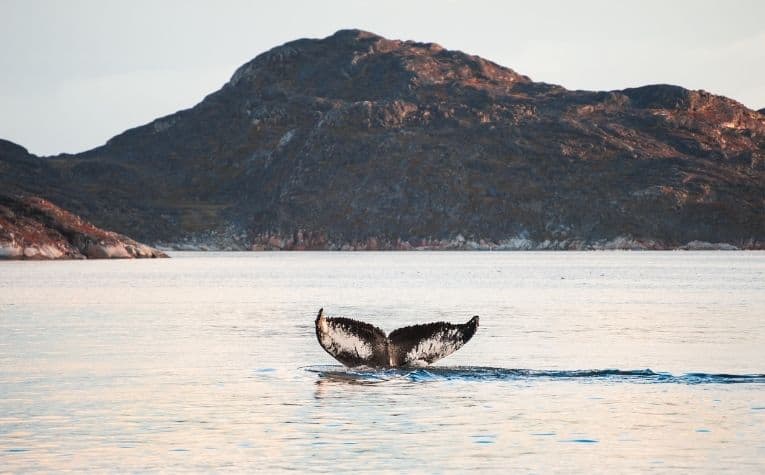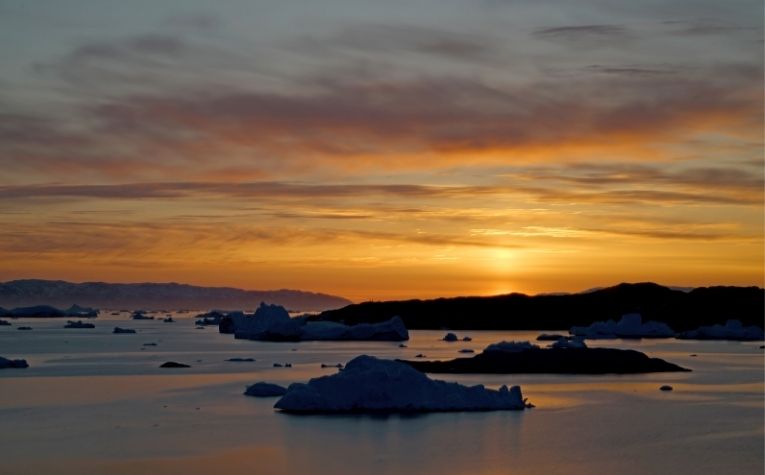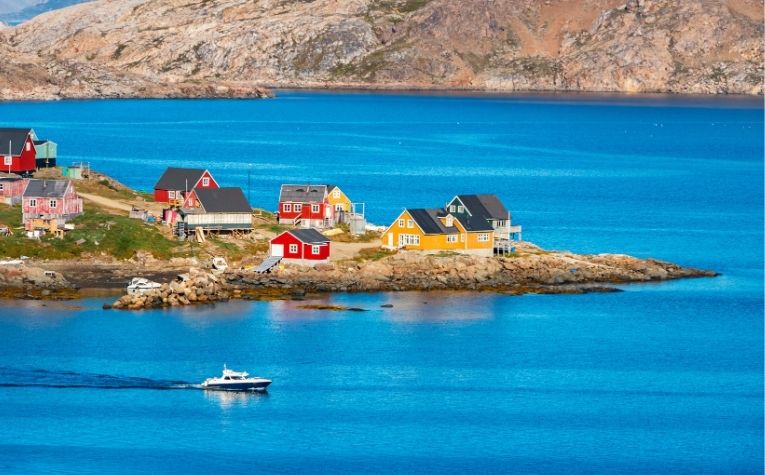Greenland and Iceland are neighbors in the North Atlantic. Though the Denmark Strait separates the island nations, they are relatively close together.
Travelers to this region of the world, as well as just the curious, may wonder how close Greenland and Iceland are. Some may even wonder, can a person see Greenland from Iceland?
If a person stands on the northwest shoreline of Iceland and looks in the direction of its island neighbor, Greenland is not visible to the naked eye.
Though the islands are relatively close together, though separated by water, they are 1,012 miles or 1629 kilometers apart.
Conventionally, at sea level, the horizon – where the sea and sky are perceived to meer – is understood to be about three miles away.
Other factors can enable people to see even further away such as the increased elevation of the seer as well as atmospheric conditions.
So, if the conditions were right, could a person in Iceland see Greenland?
Never met an Icelander? See Are Icelanders Friendly People? to learn more.

What if a person was standing at a high elevation?
What if a person on the northwest shoreline of Iceland could stand at a higher elevation? Could they see Greenland at that point?
The answer is still no because the person could not stand at a high enough point to see over 1000 miles or 1600 kilometers.
- For a person of average height on the ground, the horizon is at a distance of 4.7 kilometers or 2.9 miles.
- For an observer standing on the ground with h = 2 meters (6 ft 7 in), the horizon is at a distance of 5 kilometers (3.1 mi).
- For a person of average height standing 30 meters or 98 feet above sea level, the horizon is at a distance of 19.6 kilometers or 12.2 miles.
- For a person of average height standing 100 meters or 330 feet above sea level, the horizon is at a distance of 36 kilometers or 22 miles.
- For a person of average height standing 828 meters or 2,717 feet from ground, the horizon is at a distance of 103 kilometers or 64 miles. [1]
The highest point in Iceland is on a volcanic peak called Hvannadalshnukur. It stands at 2,110 meters or 6,920 feet tall.
If atmospheric conditions were just right an observer may be able to see a few hundred miles, assuming he or she could stand at atop the peak itself.
However, Hvannadalshnukur isn’t on the northwest corner of the island, but on the southeast corner in Vatnajökull National Park.
- Even for a person of average height standing on top of the highest point in the world, Mount Everest at 8,848 meters or 29,029 feet, the horizon is at a distance of 336 kilometers or 209 miles.
Visiting Iceland’s capital city? See Do You Need a Car in Reykjavik? to learn more.

What about atmospheric conditions in the Arctic help?
Some people have heard that the unique environment in the northern Atlantic Ocean helps people see greater distances than they could elsewhere in the world.
There are stories of people in the Arctic that testify to allegedly seeing people and places over great distances.
But is that true? Does cold weather, like is commonly experienced in Greenland and Iceland, help people see greater distances? The answer is yes.
The effect of refraction, which bends rays of light as they pass through the atmosphere, and the horizon is even farther.
Cold weather increases the amount of atmospheric refraction, so in a particularly frosty location such as Antarctica people have been able to see hundreds of miles away. [2]
Though Arctic conditions enable people to see much farther sometimes, it doesn’t enable them to see over 1600 kilometers or 1000 miles.
Could seeing Greenland from Iceland be a mirage?
While in Iceland, if a person looked northwest across the sea, and believes they saw a dark horizontal band that resembled land, they may have experienced an optical illusion, not uncommon to the region, referred to as a superior mirage. [3]
A superior mirage occurs when light passes through dense, cold air and then travels through a less dense, warm atmosphere.
When this occurs, the sun creates a mirroring effect by deflecting a dark image downward into the colder air conditions.
Much like a conventional mirage, a super mirage creates an illusion through the refraction of light, where a layer of warm air appears like a horizontal band on the water.
This dark-looking horizontal band may look like land to some observers. The optical illusion, however, is occurring just a few miles from where they are standing.
Also, see Is Greenland Part of Denmark? to learn more.
Getting closer to Greenland from Iceland
Of course the best way to see Greenland if a person is in Iceland is to get close to the large island. There are two primary ways to do this: (1) by plane and (2) by boat or ship.
Traveling to Greenland from Iceland by plane
Commonly, flights from Iceland to Greenland can take 2-4 hours because of the factors involved in the trip:
- Many of the planes making this trip are small and cannot fly as fast relative to jets.
- Weather conditions sometimes impede quick and efficient travel.
- Planes don’t necessarily fly from the northwest coast of Iceland to the southeast coast of Greenland. Instead, they fly from one airport to another, both of which can be further inland, extending travel times.
- Depending on a person’s exact destination, multiple stops may be required due to fuel needs, changing weather conditions, and various conditions on the ground. Multiple stops may be necessary, for example, if a person’s destination is a remote village.
Also, see Why Are There So Many Churches in Iceland? to learn more.

Traveling to Greenland from Iceland by ship
If a person chooses to travel by ship, they may encounter some of the same obstacles as they would by plane.
Traveling by ship may be shorter in the sense that a person is traveling from port to port.
But if they are coming from further inland and traveling to a destination that is further inland, then the length of the trip will obviously be extended.
The obstacles to traveling by ship may include:
- Weather and sea conditions in the Strait of Denmark
- Speed of travel will be slower
Yet, if a person has the time, the sights that can be seen from sailing from Iceland to Greenland may be worth the time it takes.
How does the climate affect visibility in Iceland and Greenland?
Iceland and Greenland have unique characteristics when it comes to their climates, but there are some commonalities as well.
Iceland
Some people may be surprised to learn that Iceland can have moderate temperatures at many times of the year.
The island country, however, is vulnerable to Arctic weather descending on it from the north. Yet warmer weather from the Gulf Stream impacts the country as well.
In the winter months, Iceland can reach freezing temperatures. Many residents and visitors are thankful that extremely cold temperatures often don’t last for a sustained period of time.
Greenland
Greenland is so large that the climate can be different from region to region. In some places on the island, the average high temperatures in the warmest months can reach 10 degrees Celsius or 50 degrees Fahrenheit.
The average low in certain sections can reach -11 degrees Celsius or around 10 degrees Fahrenheit.
What Months Are The Best To Visit Greenland?
Greenland has a lot to offer visitors all year round. There’s something to offer in every season.
- Summer Months (July-August): The summer months in Greenland generally span from May through September, depending on the region. Temperatures are steady during this time. July and August are the most notable months of the year to participate in taking in all of the country’s beauty with hiking activities or site seeing.
- Fall Months (September-November): The days grow shorter in the fall months in Greenland, but there’s still plenty of activities. Consider exploring the snowy grounds either on foot or with the help of some furry companions with authentic dog sledding.
- Winter (December – February): For travelers from a region with warmer climates, this can be an intense time to visit yet its a time when Greenland showcases some of its greatest wonders. For instance, the aurora borealis, the phenomenon caused by solar winds, is the most beautiful and noticeable when the sky is the darkest.
- Spring (April-May): Greenland doesn’t experience spring for very long. April and May are the least likely months to visit Greenland, but it is still one of the best opportunities to watch the transition of the seasons.
